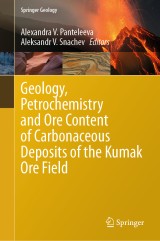Details

Geology, Petrochemistry and Ore Content of Carbonaceous Deposits of the Kumak Ore Field
Springer Geology
|
139,09 € |
|
| Verlag: | Springer |
| Format: | |
| Veröffentl.: | 11.07.2024 |
| ISBN/EAN: | 9783031609664 |
| Sprache: | englisch |
Dieses eBook enthält ein Wasserzeichen.
Beschreibungen
<p>The main prospects for expanding the mineral resource base of gold are associated with the discovery of typical ore objects within the distribution of productive black shale strata in the Orenburg part of the Southern Urals. The solution of this problem is significantly associated with the discovery, evaluation and involvement in the industrial development of gold deposits lying in the black shale strata. Their practical significance, based on existing concepts, can be considered in several aspects: first of all, it is a possible source of metals, and secondly, they are a reducing geochemical barrier for the deposition of ore matter of deep fluids. The formations of the black shale formation are a favorable geochemical environment for the primary concentration of gold, platinum group elements, tungsten, molybdenum and other metals. Areas of manifestation of tectonic activity, zonal and contact metamorphism, and the dyke complex are of great importance. Moreover, carbonaceous deposits are a very informative material for the reconstruction of paleogeographic and physico-chemical conditions of their accumulation. </p><p>In this regard, the ore-containing black shales of the Kumak deposit, whose rocks have a specialization in gold, seem to be a very attractive object for a comprehensive study of ore content. They may be of great practical importance for the search for new deposits in the Southern Urals and in other regions with a similar geological structure.</p>
<p>Geological structure and history of exploration of the Anikhov graben (Southern Urals, Russia).- Geological structure of the Kumak ore field (Southern Urals, Russia).- Petrographic features and carbonaceous matter of the black shales of the Kumak deposit (Southern Urals, Russia).- Petrogeochemical features and conditions of accumulation of carbonaceous deposits of the Bredy Formation (Southern Urals, Russia).- Ore potential of carbonaceous deposits of the Kumak deposit (Southern Urals, Russia).- Model of formation of the Kumak gold deposit (Southern Urals, Russia).- The concept of industrial development of gold deposits in the Kumak ore field (Southern Urals, Russia).</p>
<p><strong>Alexandra V. Panteleeva </strong>successfully defended her dissertation for the degree of candidate of geological and mineralogical sciences, associate professor of the department of geology, geodesy and cadastre at Orenburg State University. During the period from 2017 to 2023, she published 15 articles in journals listed on Scopus and WoS. She took part in 5 International and 4 All-Russian conferences (Kazan, Orenburg, Miass, Perm, Magnitogorsk, Ufa). In 2023, she became a co-author of a monograph.</p>
<p><strong>Aleksandr V. Snachev</strong> in 2006 defended his Ph.D. thesis. Currently he is the head of the «Ore Deposits» Laboratory at the Institute of Geology of the UFRC RAS and an associate professor at the Ufa University of Science and Technology. Author of more than 130 articles, as well as 5 monographs. Scientific interests: geology and ore content of carbonaceous deposits.</p>
<p><strong>Aleksandr V. Snachev</strong> in 2006 defended his Ph.D. thesis. Currently he is the head of the «Ore Deposits» Laboratory at the Institute of Geology of the UFRC RAS and an associate professor at the Ufa University of Science and Technology. Author of more than 130 articles, as well as 5 monographs. Scientific interests: geology and ore content of carbonaceous deposits.</p>
<p>The main prospects for expanding the mineral resource base of gold are associated with the discovery of typical ore objects within the distribution of productive black shale strata in the Orenburg part of the Southern Urals. The solution of this problem is significantly associated with the discovery, evaluation and involvement in the industrial development of gold deposits lying in the black shale strata. Their practical significance, based on existing concepts, can be considered in several aspects: first of all, it is a possible source of metals, and secondly, they are a reducing geochemical barrier for the deposition of ore matter of deep fluids. The formations of the black shale formation are a favorable geochemical environment for the primary concentration of gold, platinum group elements, tungsten, molybdenum and other metals. Areas of manifestation of tectonic activity, zonal and contact metamorphism, and the dyke complex are of great importance. Moreover, carbonaceous deposits are a very informative material for the reconstruction of paleogeographic and physico-chemical conditions of their accumulation.</p>
<p>In this regard, the ore-containing black shales of the Kumak deposit, whose rocks have a specialization in gold, seem to be a very attractive object for a comprehensive study of ore content. They may be of great practical importance for the search for new deposits in the Southern Urals and in other regions with a similar geological structure.</p>
<p>In this regard, the ore-containing black shales of the Kumak deposit, whose rocks have a specialization in gold, seem to be a very attractive object for a comprehensive study of ore content. They may be of great practical importance for the search for new deposits in the Southern Urals and in other regions with a similar geological structure.</p>
Illustrates regularities of placement and genetic features of noble metal mineralization of the black shale type Presents mineral resource associated with typical ore objects within black shale strata in Orenburg Compares new deposits in the Southern Urals with other regions with a similar geological structure
Diese Produkte könnten Sie auch interessieren:

Decision Support Systems for Risk-Based Management of Contaminated Sites

von: Antonio Marcomini, Glenn Walter Suter II, Andrea Critto

96,29 €

Dynamics of Mercury Pollution on Regional and Global Scales

von: Nicola Pirrone, Kathryn R. Mahaffey

149,79 €














